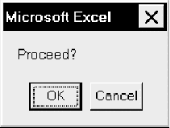The
VBA language has two types of constants. A literal
constant
(also
called a constant or literal
) is a specific value, such as a number, date, or text
string, that does not change, and that is used exactly as written.
Note that string constants are enclosed in double quotation marks, as
in "Donna
Smith" and date
constants are enclosed between number signs, as in
#1/1/96#.
For instance, the following code stores a date in the variable called
dt:
Dim dt As Date dt = #1/2/97#
A symbolic constant (also sometimes referred to simply as a constant) is a name for a literal constant.
To define or declare a symbolic constant in a program, we use the
Const keyword, as in:
Const InvoicePath = "d:\Invoices\"
In this case, Excel will replace every instance of
InvoicePath in our code with the string
"d:\Invoices\". Thus,
InvoicePath is a constant, since it never changes
value, but it is not a literal constant, since it is not used as
written.
The virtue of using symbolic constants is that, if we decide later to
change "d:\Invoices\" to
"d:\OldInvoices\", we only need to change the
definition of InvoicePath to:
Const InvoicePath = "d:\OldInvoices\"
rather than searching through the entire program for every occurrence
of the phrase "d:\Invoices\".
It is generally good programming practice to declare any symbolic constants at the beginning of the procedure in which they are used (or in the Declarations section of a code module). This improves readability and makes housekeeping simpler.
In addition to the symbolic constants that you can define using the
Const statement, VBA has a large number of
built-in symbolic constants (about 700), whose names begin with the
lowercase letters vb. Excel VBA adds additional
symbolic constants (1266 of them) that begin with the letters
xl. We will encounter many of these constants
throughout the book.
Among the most commonly used VBA constants are
vbCrLf, which is equivalent to a carriage return
followed by a line feed, and vbTab, which is
equivalent to the tab character.
Microsoft has recently introduced a structure into VBA to categorize the plethora of symbolic constants. This structure is called an enum , which is short for enumeration. A list of enums can be obtained using my Object Model Browser software. For instance, among Excel's 152 enums, there is one for the fill type used by the AutoFill method, defined as follows:
Enum XlAutoFillType
xlFillDefault = 0
xlFillCopy = 1
xlFillSeries = 2
xlFillFormats = 3
xlFillValues = 4
xlFillDays = 5
xlFillWeekdays = 6
xlFillMonths = 7
xlFillYears = 8
xlLinearTrend = 9
xlGrowthTrend = 10
End Enum(The Excel documentation incorrectly refers to this enum as
XlFillType.) Note that enum names begin with the
letters Xl (with an uppercase X
).
Thus, the following line of code will autofill the first seven cells in the first row of the active sheet with the days of the week, assuming that the first cell contains the word Monday:
ActiveSheet.Range("A1").AutoFill ActiveSheet.Range("A1:G1"), xlFillDaysThis is far more readable than:
ActiveSheet.Range("A1").AutoFill ActiveSheet.Range("A1:G1"), 5Note that this enum is built in, so we do not need to add it to our programs in order to use these symbolic constants. (We can create our own enums, but this is generally not necessary in Excel VBA programming, since Excel has done such a good job of this for us.)
As another example, the built-in enum for the constant values that can be returned when the user dismisses a message box (by clicking on a button) is:
Enum VbMsgBoxResult
vbOK = 1
vbCancel = 2
vbAbort = 3
vbRetry = 4
vbIgnore = 5
vbYes = 6
vbNo = 7
End EnumFor instance, when the user hits the OK button on a dialog box
(assuming it has one), VBA returns the value vbOK.
Certainly, it is a lot easier to remember that VBA will return the
symbolic constant vbOK than to remember that it
will return the constant 1. (We will discuss how to get and use this
return value later.)
VBA also defines some symbolic constants that are used to set the types of buttons that will appear on a message box. These are contained in the following enum (which includes some additional constants not shown):
Enum VbMsgBoxStyle
vbOKOnly = 0
vbOKCancel = 1
vbAbortRetryIgnore = 2
vbYesNoCancel = 3
vbYesNo = 4
vbRetryCancel = 5
End EnumTo illustrate, consider the following code:
If MsgBox("Proceed?", vbOKCancel) = vbOK Then
' place code to execute when user hits OK button
Else
' place code to execute when user hits any other button
End IfIn the first line, the code MsgBox("Proceed?",
vbOKCancel) causes Excel to display a message box
with an OK button and a Cancel button and the message
"Proceed?", as shown in Figure 5-1.
If the user clicks the OK button, Excel will return the constant
value vbOK; otherwise it will return the value
vbCancel. Thus, the If
statement in the first line will distinguish between the two
responses. (We will discuss the If statement in
detail in Chapter 8. Here, we are interested in
the role of symbolic constants.)
In case you are not yet convinced of the value of symbolic constants, consider the following enum for color constants:
Enum ColorConstants
vbBlack = 0
vbBlue = 16711680
vbMagenta = 16711935
vbCyan = 16776960
vbWhite = 16777215
vbRed = 255
vbGreen = 65280
vbYellow = 65535
End EnumConsider which you'd rather type, this:
ATextBox.ForeColor = vbBlue
or this:
ATextBox.ForeColor = 16711680
